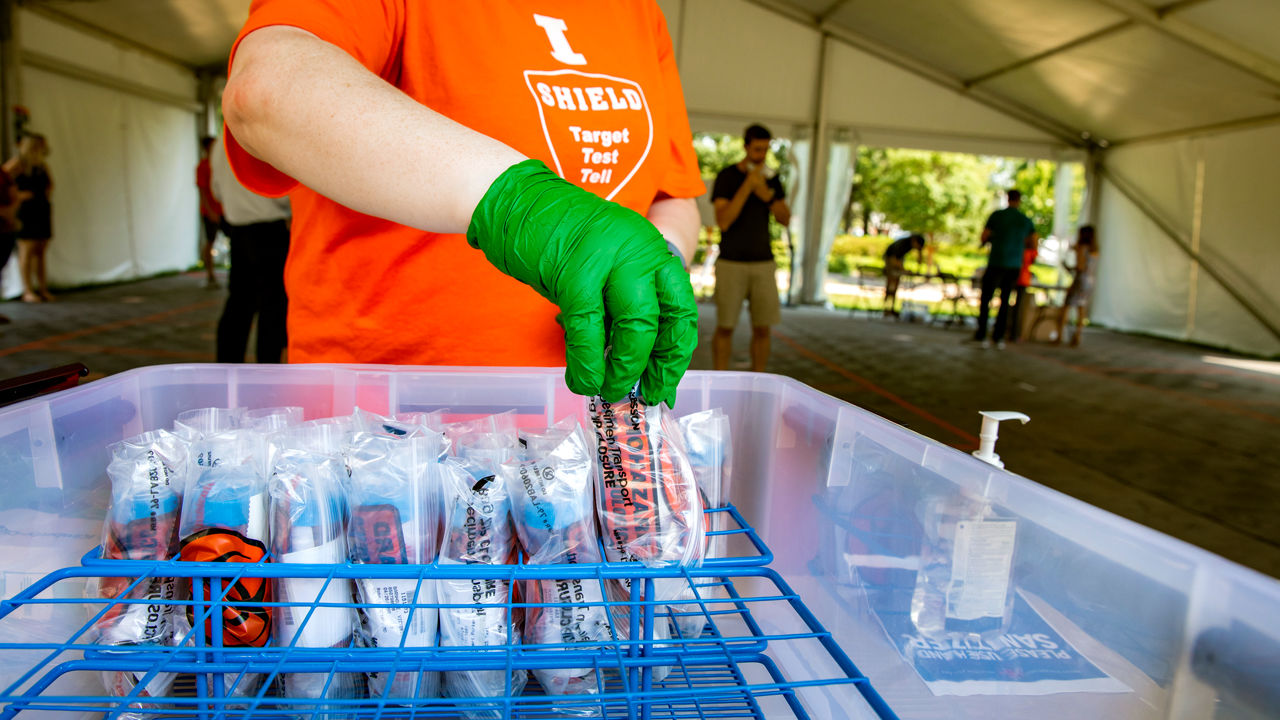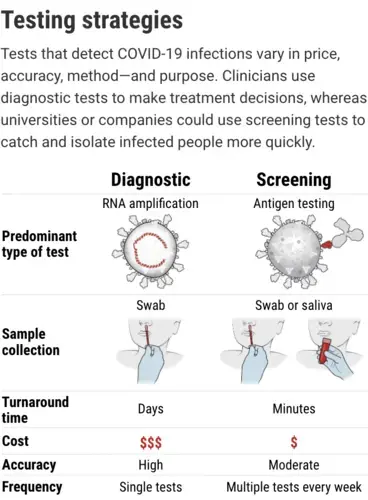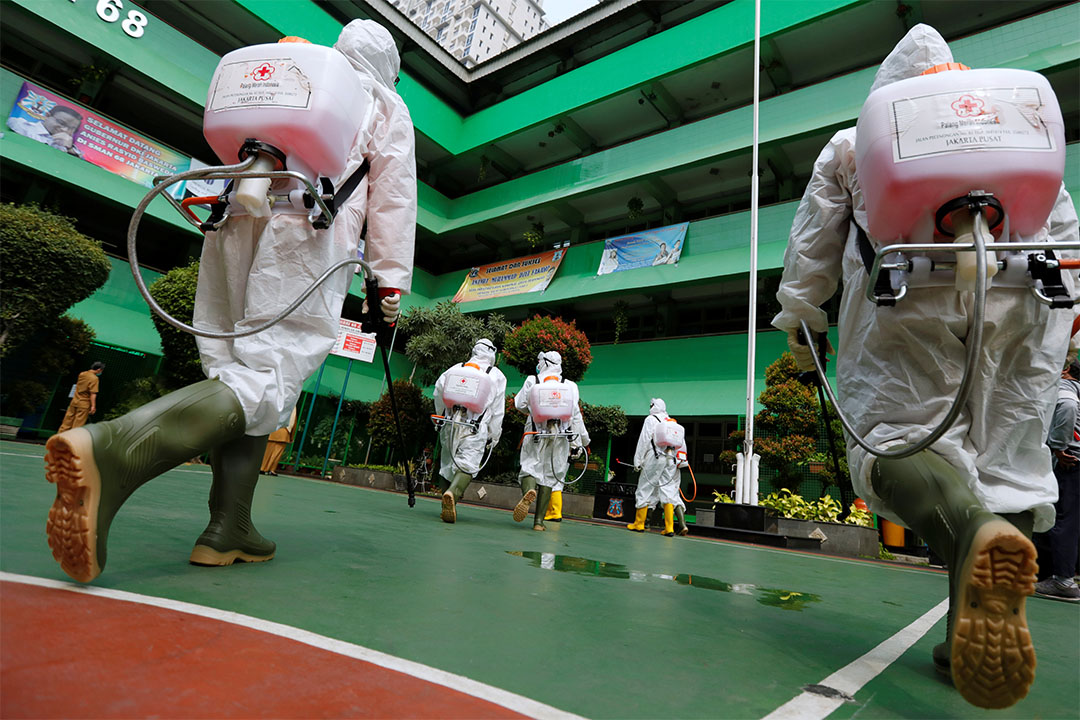
Science’s COVID-19 reporting is supported by the Pulitzer Center and the Heising-Simons Foundation.
Even as the United States ramped up coronavirus testing from about 100,000 per week in mid-March to more than 5 million per week in late July, the country fell further behind in stemming the spread of the virus. Now, diagnostics experts, public health officials, and epidemiologists are calling for a radical shift in testing strategy: away from diagnosing people who have symptoms or were exposed and toward screening whole populations using faster, cheaper, sometimes less accurate tests. By making it possible to identify and isolate infected individuals more quickly, proponents say, the shift would slow the virus’ spread, key to safely reopening schools, factories, and offices.
“America faces an impending disaster,” says Rajiv Shah, president of the Rockefeller Foundation. Testing, he says, needs to focus on “massively increasing availability of fast, inexpensive screening tests to identify asymptomatic Americans who carry the virus. Today, we are conducting too few of these types of tests.” Rebecca Smith, an epidemiologist at the University of Illinois, Urbana-Champaign (UIUC), agrees. To stop outbreaks from overwhelming communities, she says, “we need fast, frequent testing,” which could mean faster versions of existing RNA tests or new kinds of tests aimed at detecting viral proteins. But researchers say the federal government will need to provide major financial backing for the push.
Today, COVID-19 testing relies primarily on the polymerase chain reaction (PCR), a technique to amplify the virus’ genetic material, making it easy to detect. If administered properly, such tests are highly accurate, spotting positive cases nearly 100% of the time. That accuracy is vital for decisions about treating individual patients. But PCR tests cost about $100 each, require specialized machinery and reagents, and typically take at least 1 to 2 days to return results.
The recent increase in coronavirus cases across the United States has added to the delay, pushing wait times to 2 weeks in some places. While they wait, people who are infected but don’t yet know it may continue to interact with others and spread the virus. And if their infective period ends before they get their results, isolating them won’t help. “It’s like calling the fire department after your house burns to the ground,” says A. David Paltiel, an operations research expert at the Yale School of Public Health. “You can’t play catch up with this virus.”
A 24 July preprint on medRxiv underscored the downsides of slow tests. Shixiong Hu, a researcher with the Hunan Provincial Center for Disease Control and Prevention, and his colleagues followed 1179 people who tested positive for SARS-CoV-2 from January to April and tested their 15,648 contacts, defined as people who had been within 1 meter of a positive person between 2 days before and 14 days after the person’s symptoms began. Based on which contacts were infected and when, the researchers estimated that people were most likely to spread the virus 1.8 days before the onset of symptoms. The finding suggests testing people only when they show symptoms and giving them test results days to weeks later does little to slow viral spread, says Daniel Larremore, an applied mathematician at the University of Colorado, Boulder.
Larremore and his colleagues have modeled the benefits of more frequent tests, even ones that are less accurate than today’s. Fast tests repeated every 3 days, with isolation of people who test positive, prevents 88% of viral transmission compared with no tests; a more sensitive test used every 2 weeks reduced viral transmission by about 40%, they report in a 27 June preprint on medRxiv. Paltiel and his colleagues reached much the same conclusion when they modeled a variety of testing regimes aimed at safely reopening a 5000-student university. In a 31 July paper in JAMA Network Open, they found that, with 10 students infected at the start of the semester, a test that identified only 70% of positive cases, given to every student every 2 days, could limit the number of infections to 28 by the end of the semester. Screening every 7 days allowed greater viral spread, with the model predicting 108 infections. “A higher frequency of testing makes up for poor sensitivity,” Paltiel says.

Smith says these and related studies have prompted UIUC to set up tests for all 60,000 students and faculty multiple times per week when the students return to campus this fall. The approach relies on an experimental fast PCR setup described in an 18 June preprint that bypasses some of the usual slow procedures for isolating viral RNA and tests saliva rather than throat swabs, says Martin Burke, a UIUC chemist who was one of the test’s developers. Smith says her team predicts that if the university tests everyone every 3 to 4 days, on average, it will detect positive cases half a day before those people reach peak infectivity. “Fast and repeated testing is crucial,” Smith says. Antigen tests, which immobilize antibodies on a test strip, promise an even greater speedup. Those antibodies detect viral proteins in saliva or a nasal swab. Such tests cost as little as $1 to $2 each, give a yes/no readout within minutes much like a pregnancy test, and are already used to detect influenza, HIV, and other viruses. Two companies—Quidel Corporation and Becton, Dickinson and Company (BD)—have received emergency use authorization from the U.S. Food and Drug Administration to sell antigen tests for SARS-CoV-2. Other companies have similar tests in the works.
Because antigen tests don’t amplify viral material but simply detect what is present in the sample, they are less accurate than PCR. Some antigen tests correctly detect only one-half to three-quarters of infections. But they could still be a valuable health tool if performed often enough; few infected people would be missed in multiple rounds of tests. And people who receive a positive antigen test could be isolated and retested with a PCR test to confirm the result. On 16 July, the Rockefeller Foundation released a national COVID-19 testing plan calling on the federal government to spend $75 billion on providing 30 million screening and diagnostic tests per week.
Among the hurdles facing widespread, repeat screening is the scarcity of such tests. Quidel and BD together manufacture about 3 million antigen tests per week. But a national screening strategy would likely require 25 million tests or more, says Jonathan Quick, who heads pandemic response for the Rockefeller Foundation.
Quick says companies are reluctant to ramp up production dramatically if they are unsure of the market for the products. One solution, he adds, could be a promise by the federal government to buy tens of millions of tests, much as it has done with vaccine doses. Or the Trump administration could take over test production using the Defense Production Act, which allows federal government to direct private companies to meet national defense needs. “I don’t think it’s either/or,” Quick says about purchase agreements or the Defense Production Act. “It’s and/both. We don’t have time to wait.”
Help could also come from a National Institutes of Health test development program, which last week announced nearly $250 million in awards to seven companies for scaling up production of novel rapid SARS-CoV-2 tests, with a goal of reaching some 42 million tests per week by the end of this year.
Even with federal help, broad screening programs are likely to be costly. Paltiel’s study estimated that testing 5000 students every 3 days for an abbreviated 80-day semester would cost about $1.5 million, which may be beyond the reach of many universities, let alone high schools and small businesses. But if organizations won’t or can’t make the investment, Paltiel asserts, “they have to ask themselves if they have any business reopening.” Quick adds: “Investing will be far less costly for the nation than another economic shutdown, which will happen if we don’t contain the outbreaks.”
COVID-19 Update: The connection between local and global issues–the Pulitzer Center's long standing mantra–has, sadly, never been more evident. We are uniquely positioned to serve the journalists, news media organizations, schools and universities we partner with by continuing to advance our core mission: enabling great journalism and education about underreported and systemic issues that resonate now–and continue to have relevance in times ahead. We believe that this is a moment for decisive action. Learn more about the steps we are taking.









